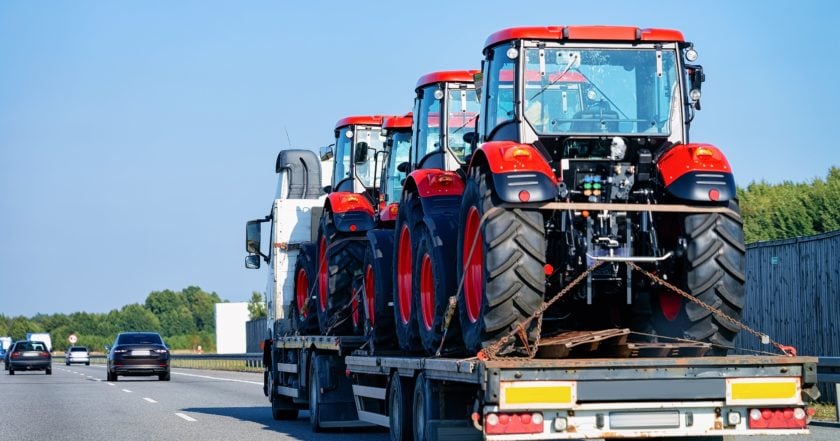Heavy-duty shipping requires extensive planning and preparations because of the equipment’s heavy weight and large dimension that requires special handling. Heavy-duty shippers must be proactive in the planning process and consider all factors related to safe and hassle-free transport, from having the right equipment at hand to efficiently planning accessible routes.
This guide covers several aspects of appropriate heavy-duty shipping, including the following:
- Heavy-Duty Shipping
- Essential Tie-Down Methods for Heavy-Duty Shipping
- General Heavy-Duty Shipping Tips
Heavy-Duty Shipping
It is vital to clearly introduce and explain the heavy-duty shipping process before diving deep into the practices of securing this equipment. Heavy-duty shipping entails collaborating with a professional staff of auto shippers to prepare for transporting a heavy truck, machinery, or equipment from one point to another.
The process of preparing for heavy-duty shipping is lengthy and involves a lot of details. Furthermore, this service is meant to ship farming, manufacturing, construction, and other equipment between different worksites or from dealers to owners. Heavy-duty equipment includes bulldozers, tractors, hoes, hoists, etc.
How to Ship Heavy-Duty Equipment?
This is quite a broad question since the heavy-duty shipping process consists of several stages. In fact, it is a complicated process that takes time, attention, and accuracy. However, provided in the following are major takeaways to know about heavy-duty shipping:
Know the Heavy-Duty Specifications
The first step in shipping heavy-duty equipment is checking for its exact weight, size, length, and width information. Knowing accurate information about heavy-duty equipment is crucial to properly arranging for its shipment and preparing the right tools.
Heavy-duty owners or shippers can find this information in the equipment manufacturer manual, which contains everything related to the specific equipment. It details heavy-duty equipment, from its dimensions and other characteristics to helpful guidelines on safely operating and managing the equipment, preparing it for shipping, and handling it during transport.
Choose the Right Trailer Type
Several types of trailers ship different vehicles and meet each’s specific needs. Flatbed, lowboy, and drop-deck trailers are most commonly used for heavy-duty shipping. Flatbeds are sideless trailers allowing easy and smooth vehicles loading and unloading. They can be used to ship different vehicle types, especially heavy-duty equipment.
On the other hand, lowboys acquired this name because they sit low on the ground and are effective for shipping taller equipment. Lowboys allow shippers to transport tall, heavy equipment easily and save on the costs of bringing the required shipping permits.
Finally, drop-deck or step-deck trailers are primarily known for their flexibility since they allow auto shippers to control the trailer height depending on the load’s requirements. Drop-deck trailers are also perfect for shipping tall and heavy equipment.
Obtain the Required Shipping Permits
Heavy-duty shippers must apply for and obtain permits for overweight or over-height loads. The permit is issued by the official facilities regulating auto shipping in the United States, the state’s Department of Transportation, and the Federal Motor Carrier Safety and Administration. It also ensures a safe heavy-duty shipping process and minimizes fatal road accident risks.
Essential Tie-Down Methods for Heavy-Duty Shipping
Now the general aspect of heavy-duty shipping is made clearer. It is time to explain how heavy-duty shippers secure the loads and their essential tie-down methods. As suggested earlier, heavy-duty shippers can refer to the manufacturer manual to find helpful information and guidelines for proper load securement.
They can find step-by-step instructions about loading, securing, and unloading the equipment from and to the shipping trailer, in addition to important information like the required tie-downs, required securing tools’ weight capacity, and the Working Load Limit rate.
Above all, the following are the basic tie-down methods for heavy-duty shipping:
Number of Tie-Downs
The USDOT dictates how many tie-downs heavy-duty shippers must use to secure their loads safely. Heavy-duty equipment must be secured using a minimum of four tie-downs, each with a Working Load Limit of at least 5000 pounds.
Still, the general cargo securement requirements indicate that the total Working Load Limit of all the tie-downs must be equal to half the loads’ weight, which means using more tie-downs can be required.
In addition, heavy-duty shippers must attach tie-downs to the front and rear of the equipment at a 45-degree angle. Then, tie-downs must be connected to specifically designed mounting points on the trailer. Moreover, heavy-duty shippers must use additional tie-downs to secure the equipment’s accessories, such as hydraulic booms and shovels.
Inspecting Tie-Downs
Heavy-duty shippers must inspect the tie-downs they will use before everything else. Tie-downs must be in good working condition, enabling them to properly hold the equipment throughout the entire transport journey.
In addition, shippers of heavy machinery must regularly check for signs of abrasion, damage, and wear-and-tear on all the tie-downs they intend to use.
Conducting a thorough inspection of the trailer and equipment tie-down points helps ensure the load will be tightly secured. It eliminates the risks of the equipment unfastening, loosening, and shifting while in transit.
Proper Load Securement to the Tie-Downs
Heavy loads must be tightly secured to tie-downs by attaching them using strong hooks, claps, or ties that will not unfasten during transportation. Then, heavy-duty shippers must secure the equipment using chains or steel strapping, both of which can keep the machinery perfectly secured.
Indeed, shippers of heavy loads sometimes use edge protection to eliminate the risks of having the tie-downs cut by the equipment components. Chocks, wedges, and cradles are also used to secure the machinery’s wheels and prevent it from moving around.
Finally, heavy-duty machinery’s parking brake must be applied on the equipment as required by the USDOT regulations before leaving it.
Securing the Equipment’s Accessories
The equipment’s accessories must also be properly secured, following the USDOT’s load securement requirements. The equipment accessory must be prevented from loosening or unfastening during transport.
Additionally, the equipment attachments must all be lowered and safely secured before transportation by pulling back and strapping retractable parts, locking the equipment’s doors and tailgate, and securing other components that can become loose.
General Heavy-Duty Shipping Tips
Other recommended practices and tips remain while shipping heavy-duty machinery in addition to the previously mentioned instructions. Here are our top three tips for maximized safety during heavy-duty shipping:
- Always comply with the USDOT regulations and recommendations: Following rules are for the security of heavy-duty shippers and their loads, primarily designed to encourage safe shipping practices and save road users from potential risks on the road. The USDOT rules have a major contribution to reducing accidents and minimizing losses.
- Test the equipment’s safety before making the real journey: Heavy-duty shippers are recommended to make a test drive during which they can ensure that the loads are evenly distributed, tightly secured against shifting and rolling, and the trailer is manageable and easy to maneuver.
- Regularly inspect loads’ securement: It is a sound practice to make regular stops during heavy-duty shipping and check for load security. Regular load inspection allows drivers to spot changes in the securing tools and fix them before leading to a serious accident.
After all, collaborating with a professional and expert auto transport company to arrange heavy-duty shipping is the best way to maximize load safety and avoid breaking the law.
Tempus Logix is a professional, reputable, and experienced car shipping company that provides shipping services for heavy-duty equipment. The company’s seasoned team can properly arrange the shipment of your heavy equipment from A to Z with the least hassle.
Conclusion
Handling heavy-duty shipping requires a lot of expertise, professionalism, and skill to ensure equipment safety during transportation. Professional auto shippers follow the USDOT regulations regarding load securement and know how to use the right equipment without damaging the machinery, making the process goes smoothly.










